Corporate Finance: BPT Company Valuation and Incentive Analysis
VerifiedAdded on 2020/01/21
|11
|2893
|79
Homework Assignment
AI Summary
This corporate finance assignment analyzes BPT's financial performance, focusing on the RV Division. It includes calculating the company's after-tax WACC, RV Division's WACC, and assessing business risk compared to industry competitors. The assignment requires completing a free cash flow table, calculating terminal value, and determining the present value of the RV Division with and without expansion. It also involves calculating the value of expansion and abandonment options, economic depreciation, and analyzing shareholder and management incentives. The analysis extends to calculating the alternative divisional WACC, identifying financing sources, determining the final dividend amount, and calculating implied dividends, along with a discussion on the DRP discount. The solution provides detailed calculations and explanations for each aspect of the financial analysis.
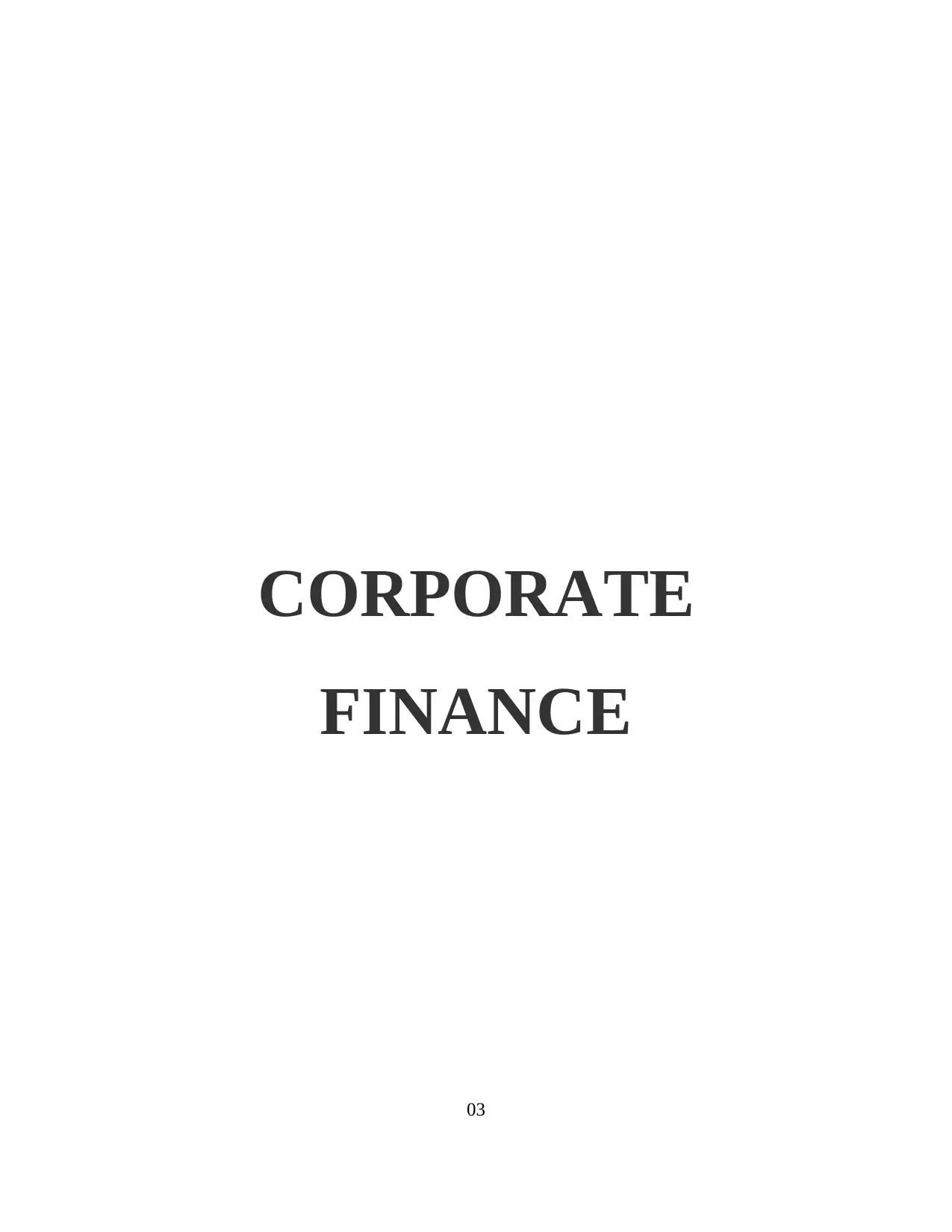
CORPORATE
FINANCE
03
FINANCE
03
Paraphrase This Document
Need a fresh take? Get an instant paraphrase of this document with our AI Paraphraser
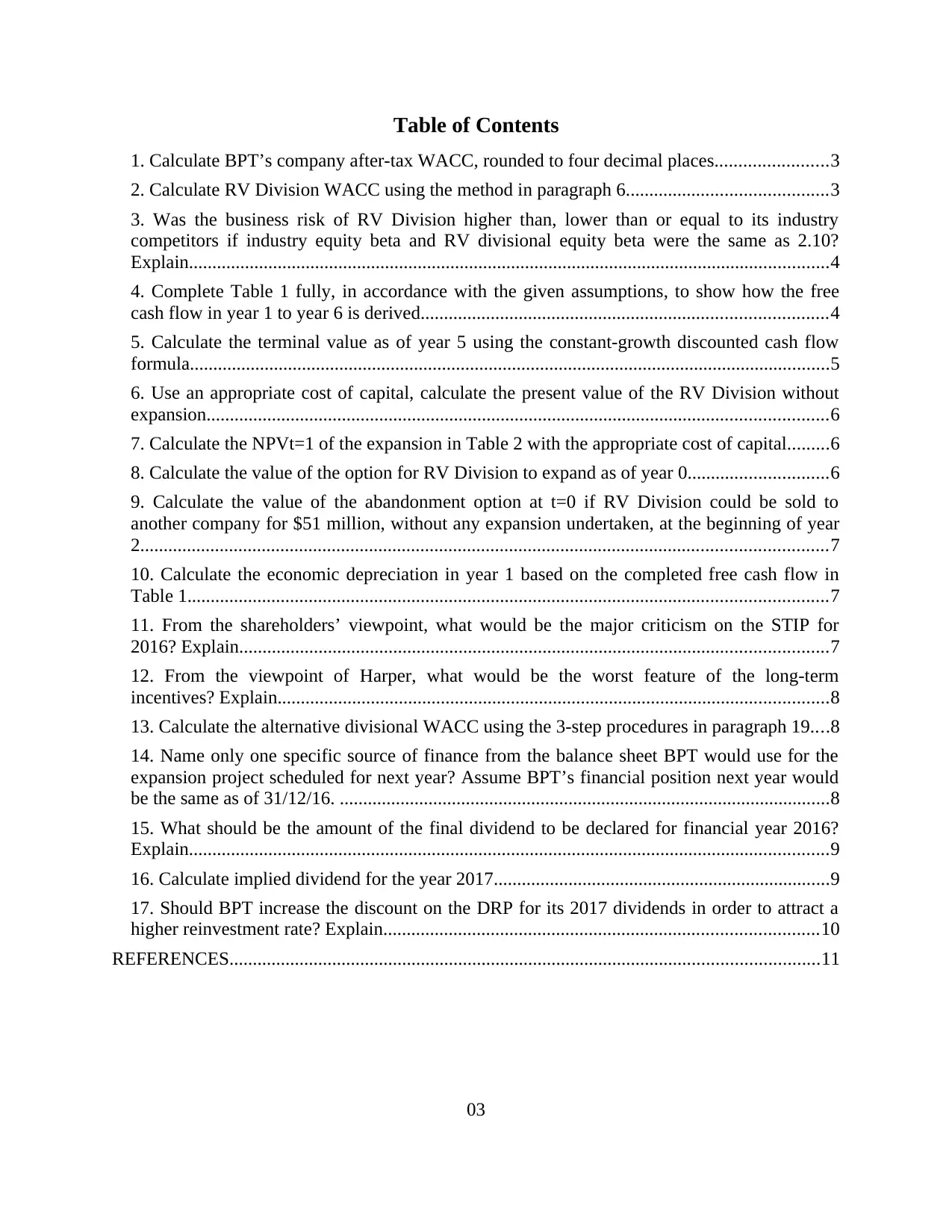
Table of Contents
1. Calculate BPT’s company after-tax WACC, rounded to four decimal places........................3
2. Calculate RV Division WACC using the method in paragraph 6...........................................3
3. Was the business risk of RV Division higher than, lower than or equal to its industry
competitors if industry equity beta and RV divisional equity beta were the same as 2.10?
Explain.........................................................................................................................................4
4. Complete Table 1 fully, in accordance with the given assumptions, to show how the free
cash flow in year 1 to year 6 is derived.......................................................................................4
5. Calculate the terminal value as of year 5 using the constant-growth discounted cash flow
formula.........................................................................................................................................5
6. Use an appropriate cost of capital, calculate the present value of the RV Division without
expansion.....................................................................................................................................6
7. Calculate the NPVt=1 of the expansion in Table 2 with the appropriate cost of capital.........6
8. Calculate the value of the option for RV Division to expand as of year 0..............................6
9. Calculate the value of the abandonment option at t=0 if RV Division could be sold to
another company for $51 million, without any expansion undertaken, at the beginning of year
2...................................................................................................................................................7
10. Calculate the economic depreciation in year 1 based on the completed free cash flow in
Table 1.........................................................................................................................................7
11. From the shareholders’ viewpoint, what would be the major criticism on the STIP for
2016? Explain..............................................................................................................................7
12. From the viewpoint of Harper, what would be the worst feature of the long-term
incentives? Explain......................................................................................................................8
13. Calculate the alternative divisional WACC using the 3-step procedures in paragraph 19....8
14. Name only one specific source of finance from the balance sheet BPT would use for the
expansion project scheduled for next year? Assume BPT’s financial position next year would
be the same as of 31/12/16. .........................................................................................................8
15. What should be the amount of the final dividend to be declared for financial year 2016?
Explain.........................................................................................................................................9
16. Calculate implied dividend for the year 2017........................................................................9
17. Should BPT increase the discount on the DRP for its 2017 dividends in order to attract a
higher reinvestment rate? Explain.............................................................................................10
REFERENCES..............................................................................................................................11
03
1. Calculate BPT’s company after-tax WACC, rounded to four decimal places........................3
2. Calculate RV Division WACC using the method in paragraph 6...........................................3
3. Was the business risk of RV Division higher than, lower than or equal to its industry
competitors if industry equity beta and RV divisional equity beta were the same as 2.10?
Explain.........................................................................................................................................4
4. Complete Table 1 fully, in accordance with the given assumptions, to show how the free
cash flow in year 1 to year 6 is derived.......................................................................................4
5. Calculate the terminal value as of year 5 using the constant-growth discounted cash flow
formula.........................................................................................................................................5
6. Use an appropriate cost of capital, calculate the present value of the RV Division without
expansion.....................................................................................................................................6
7. Calculate the NPVt=1 of the expansion in Table 2 with the appropriate cost of capital.........6
8. Calculate the value of the option for RV Division to expand as of year 0..............................6
9. Calculate the value of the abandonment option at t=0 if RV Division could be sold to
another company for $51 million, without any expansion undertaken, at the beginning of year
2...................................................................................................................................................7
10. Calculate the economic depreciation in year 1 based on the completed free cash flow in
Table 1.........................................................................................................................................7
11. From the shareholders’ viewpoint, what would be the major criticism on the STIP for
2016? Explain..............................................................................................................................7
12. From the viewpoint of Harper, what would be the worst feature of the long-term
incentives? Explain......................................................................................................................8
13. Calculate the alternative divisional WACC using the 3-step procedures in paragraph 19....8
14. Name only one specific source of finance from the balance sheet BPT would use for the
expansion project scheduled for next year? Assume BPT’s financial position next year would
be the same as of 31/12/16. .........................................................................................................8
15. What should be the amount of the final dividend to be declared for financial year 2016?
Explain.........................................................................................................................................9
16. Calculate implied dividend for the year 2017........................................................................9
17. Should BPT increase the discount on the DRP for its 2017 dividends in order to attract a
higher reinvestment rate? Explain.............................................................................................10
REFERENCES..............................................................................................................................11
03
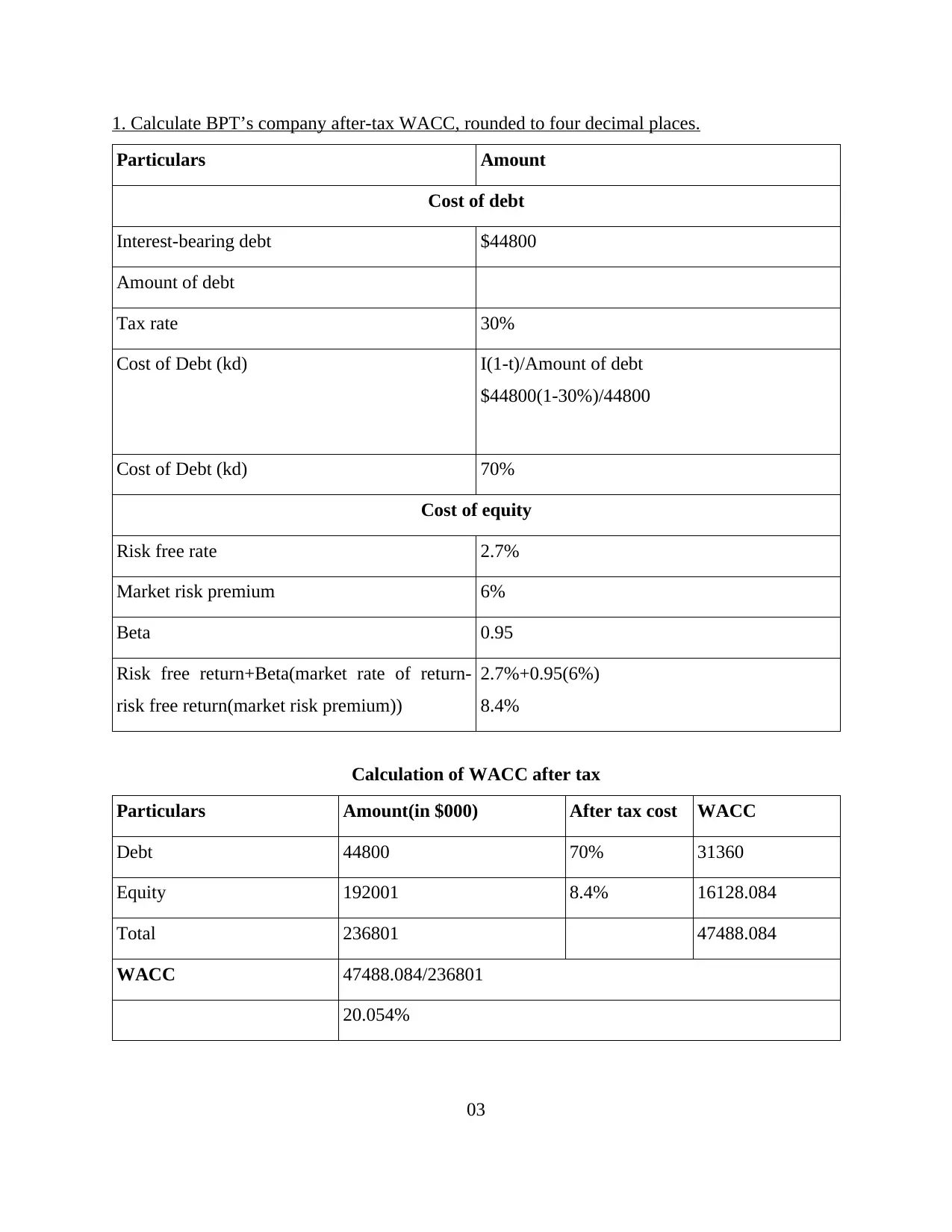
1. Calculate BPT’s company after-tax WACC, rounded to four decimal places.
Particulars Amount
Cost of debt
Interest-bearing debt $44800
Amount of debt
Tax rate 30%
Cost of Debt (kd) I(1-t)/Amount of debt
$44800(1-30%)/44800
Cost of Debt (kd) 70%
Cost of equity
Risk free rate 2.7%
Market risk premium 6%
Beta 0.95
Risk free return+Beta(market rate of return-
risk free return(market risk premium))
2.7%+0.95(6%)
8.4%
Calculation of WACC after tax
Particulars Amount(in $000) After tax cost WACC
Debt 44800 70% 31360
Equity 192001 8.4% 16128.084
Total 236801 47488.084
WACC 47488.084/236801
20.054%
03
Particulars Amount
Cost of debt
Interest-bearing debt $44800
Amount of debt
Tax rate 30%
Cost of Debt (kd) I(1-t)/Amount of debt
$44800(1-30%)/44800
Cost of Debt (kd) 70%
Cost of equity
Risk free rate 2.7%
Market risk premium 6%
Beta 0.95
Risk free return+Beta(market rate of return-
risk free return(market risk premium))
2.7%+0.95(6%)
8.4%
Calculation of WACC after tax
Particulars Amount(in $000) After tax cost WACC
Debt 44800 70% 31360
Equity 192001 8.4% 16128.084
Total 236801 47488.084
WACC 47488.084/236801
20.054%
03
⊘ This is a preview!⊘
Do you want full access?
Subscribe today to unlock all pages.

Trusted by 1+ million students worldwide
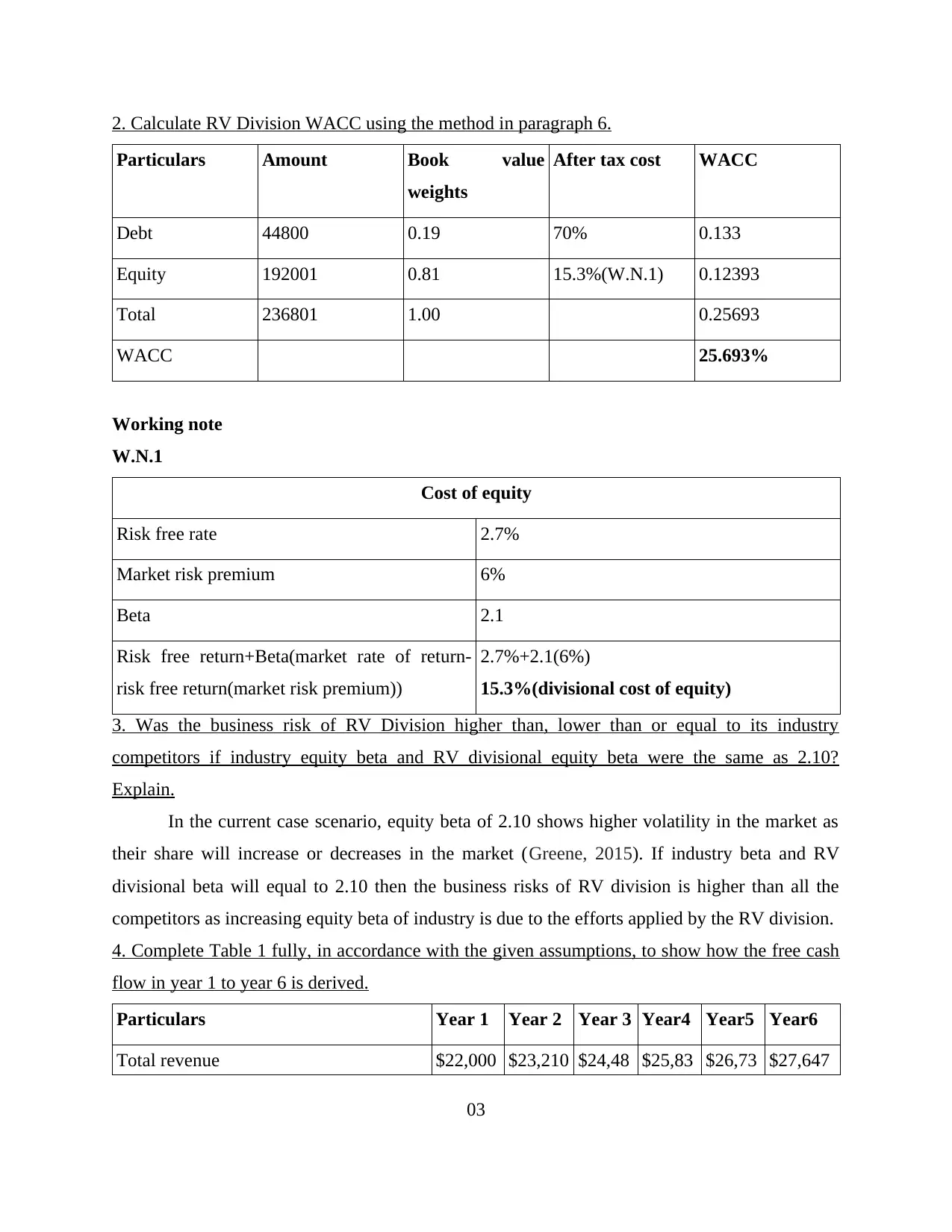
2. Calculate RV Division WACC using the method in paragraph 6.
Particulars Amount Book value
weights
After tax cost WACC
Debt 44800 0.19 70% 0.133
Equity 192001 0.81 15.3%(W.N.1) 0.12393
Total 236801 1.00 0.25693
WACC 25.693%
Working note
W.N.1
Cost of equity
Risk free rate 2.7%
Market risk premium 6%
Beta 2.1
Risk free return+Beta(market rate of return-
risk free return(market risk premium))
2.7%+2.1(6%)
15.3%(divisional cost of equity)
3. Was the business risk of RV Division higher than, lower than or equal to its industry
competitors if industry equity beta and RV divisional equity beta were the same as 2.10?
Explain.
In the current case scenario, equity beta of 2.10 shows higher volatility in the market as
their share will increase or decreases in the market (Greene, 2015). If industry beta and RV
divisional beta will equal to 2.10 then the business risks of RV division is higher than all the
competitors as increasing equity beta of industry is due to the efforts applied by the RV division.
4. Complete Table 1 fully, in accordance with the given assumptions, to show how the free cash
flow in year 1 to year 6 is derived.
Particulars Year 1 Year 2 Year 3 Year4 Year5 Year6
Total revenue $22,000 $23,210 $24,48 $25,83 $26,73 $27,647
03
Particulars Amount Book value
weights
After tax cost WACC
Debt 44800 0.19 70% 0.133
Equity 192001 0.81 15.3%(W.N.1) 0.12393
Total 236801 1.00 0.25693
WACC 25.693%
Working note
W.N.1
Cost of equity
Risk free rate 2.7%
Market risk premium 6%
Beta 2.1
Risk free return+Beta(market rate of return-
risk free return(market risk premium))
2.7%+2.1(6%)
15.3%(divisional cost of equity)
3. Was the business risk of RV Division higher than, lower than or equal to its industry
competitors if industry equity beta and RV divisional equity beta were the same as 2.10?
Explain.
In the current case scenario, equity beta of 2.10 shows higher volatility in the market as
their share will increase or decreases in the market (Greene, 2015). If industry beta and RV
divisional beta will equal to 2.10 then the business risks of RV division is higher than all the
competitors as increasing equity beta of industry is due to the efforts applied by the RV division.
4. Complete Table 1 fully, in accordance with the given assumptions, to show how the free cash
flow in year 1 to year 6 is derived.
Particulars Year 1 Year 2 Year 3 Year4 Year5 Year6
Total revenue $22,000 $23,210 $24,48 $25,83 $26,73 $27,647
03
Paraphrase This Document
Need a fresh take? Get an instant paraphrase of this document with our AI Paraphraser
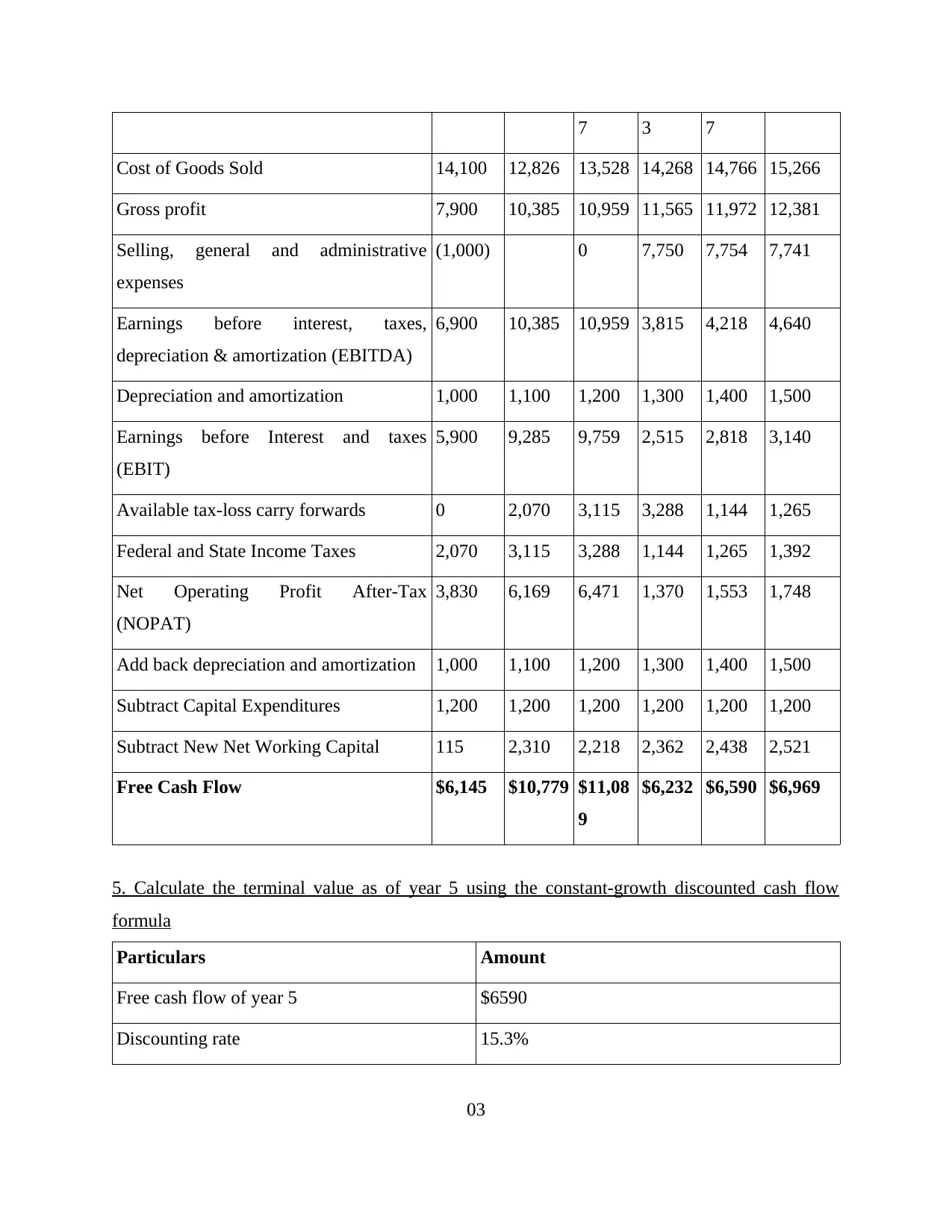
7 3 7
Cost of Goods Sold 14,100 12,826 13,528 14,268 14,766 15,266
Gross profit 7,900 10,385 10,959 11,565 11,972 12,381
Selling, general and administrative
expenses
(1,000) 0 7,750 7,754 7,741
Earnings before interest, taxes,
depreciation & amortization (EBITDA)
6,900 10,385 10,959 3,815 4,218 4,640
Depreciation and amortization 1,000 1,100 1,200 1,300 1,400 1,500
Earnings before Interest and taxes
(EBIT)
5,900 9,285 9,759 2,515 2,818 3,140
Available tax-loss carry forwards 0 2,070 3,115 3,288 1,144 1,265
Federal and State Income Taxes 2,070 3,115 3,288 1,144 1,265 1,392
Net Operating Profit After-Tax
(NOPAT)
3,830 6,169 6,471 1,370 1,553 1,748
Add back depreciation and amortization 1,000 1,100 1,200 1,300 1,400 1,500
Subtract Capital Expenditures 1,200 1,200 1,200 1,200 1,200 1,200
Subtract New Net Working Capital 115 2,310 2,218 2,362 2,438 2,521
Free Cash Flow $6,145 $10,779 $11,08
9
$6,232 $6,590 $6,969
5. Calculate the terminal value as of year 5 using the constant-growth discounted cash flow
formula
Particulars Amount
Free cash flow of year 5 $6590
Discounting rate 15.3%
03
Cost of Goods Sold 14,100 12,826 13,528 14,268 14,766 15,266
Gross profit 7,900 10,385 10,959 11,565 11,972 12,381
Selling, general and administrative
expenses
(1,000) 0 7,750 7,754 7,741
Earnings before interest, taxes,
depreciation & amortization (EBITDA)
6,900 10,385 10,959 3,815 4,218 4,640
Depreciation and amortization 1,000 1,100 1,200 1,300 1,400 1,500
Earnings before Interest and taxes
(EBIT)
5,900 9,285 9,759 2,515 2,818 3,140
Available tax-loss carry forwards 0 2,070 3,115 3,288 1,144 1,265
Federal and State Income Taxes 2,070 3,115 3,288 1,144 1,265 1,392
Net Operating Profit After-Tax
(NOPAT)
3,830 6,169 6,471 1,370 1,553 1,748
Add back depreciation and amortization 1,000 1,100 1,200 1,300 1,400 1,500
Subtract Capital Expenditures 1,200 1,200 1,200 1,200 1,200 1,200
Subtract New Net Working Capital 115 2,310 2,218 2,362 2,438 2,521
Free Cash Flow $6,145 $10,779 $11,08
9
$6,232 $6,590 $6,969
5. Calculate the terminal value as of year 5 using the constant-growth discounted cash flow
formula
Particulars Amount
Free cash flow of year 5 $6590
Discounting rate 15.3%
03
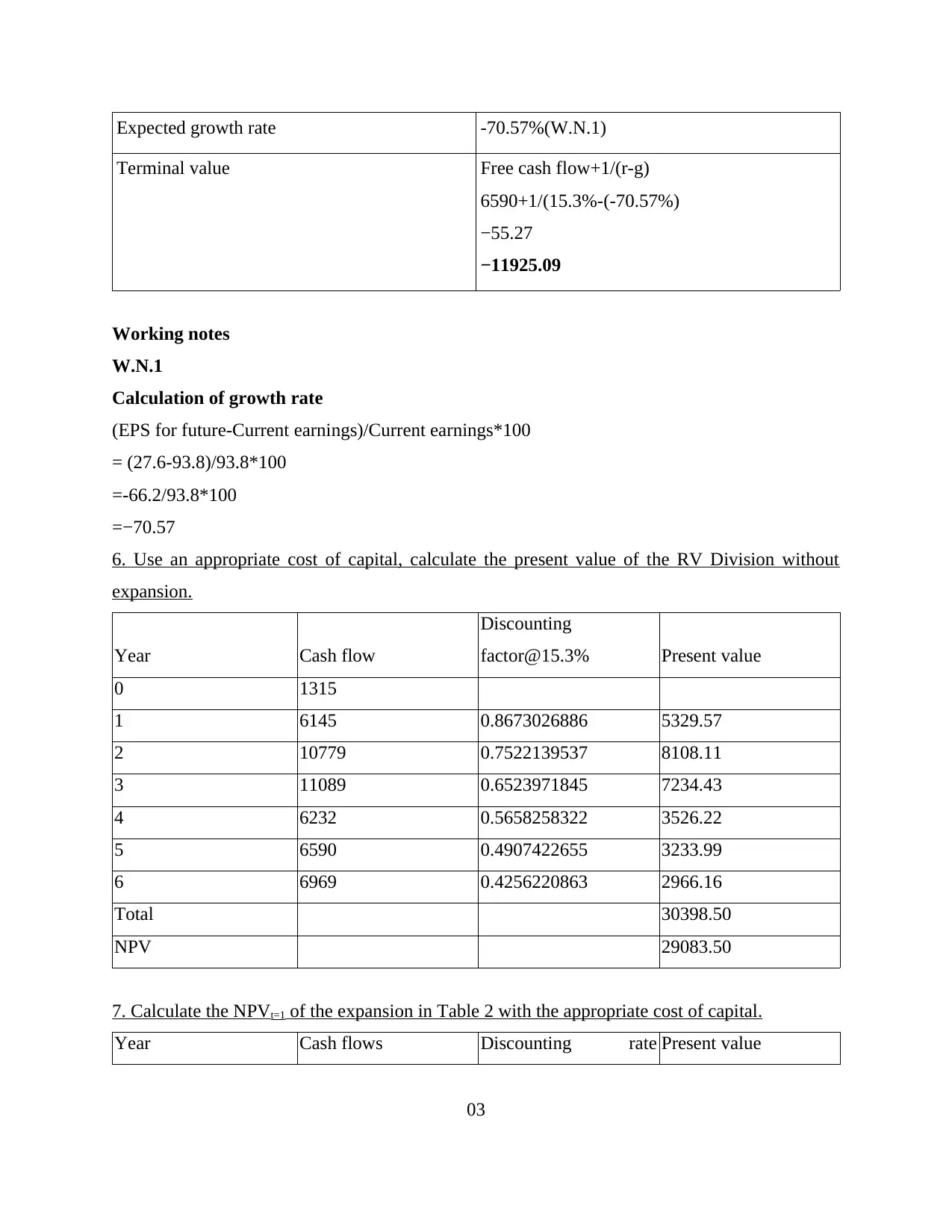
Expected growth rate -70.57%(W.N.1)
Terminal value Free cash flow+1/(r-g)
6590+1/(15.3%-(-70.57%)
−55.27
−11925.09
Working notes
W.N.1
Calculation of growth rate
(EPS for future-Current earnings)/Current earnings*100
= (27.6-93.8)/93.8*100
=-66.2/93.8*100
=−70.57
6. Use an appropriate cost of capital, calculate the present value of the RV Division without
expansion.
Year Cash flow
Discounting
factor@15.3% Present value
0 1315
1 6145 0.8673026886 5329.57
2 10779 0.7522139537 8108.11
3 11089 0.6523971845 7234.43
4 6232 0.5658258322 3526.22
5 6590 0.4907422655 3233.99
6 6969 0.4256220863 2966.16
Total 30398.50
NPV 29083.50
7. Calculate the NPVt=1 of the expansion in Table 2 with the appropriate cost of capital.
Year Cash flows Discounting rate Present value
03
Terminal value Free cash flow+1/(r-g)
6590+1/(15.3%-(-70.57%)
−55.27
−11925.09
Working notes
W.N.1
Calculation of growth rate
(EPS for future-Current earnings)/Current earnings*100
= (27.6-93.8)/93.8*100
=-66.2/93.8*100
=−70.57
6. Use an appropriate cost of capital, calculate the present value of the RV Division without
expansion.
Year Cash flow
Discounting
factor@15.3% Present value
0 1315
1 6145 0.8673026886 5329.57
2 10779 0.7522139537 8108.11
3 11089 0.6523971845 7234.43
4 6232 0.5658258322 3526.22
5 6590 0.4907422655 3233.99
6 6969 0.4256220863 2966.16
Total 30398.50
NPV 29083.50
7. Calculate the NPVt=1 of the expansion in Table 2 with the appropriate cost of capital.
Year Cash flows Discounting rate Present value
03
⊘ This is a preview!⊘
Do you want full access?
Subscribe today to unlock all pages.

Trusted by 1+ million students worldwide
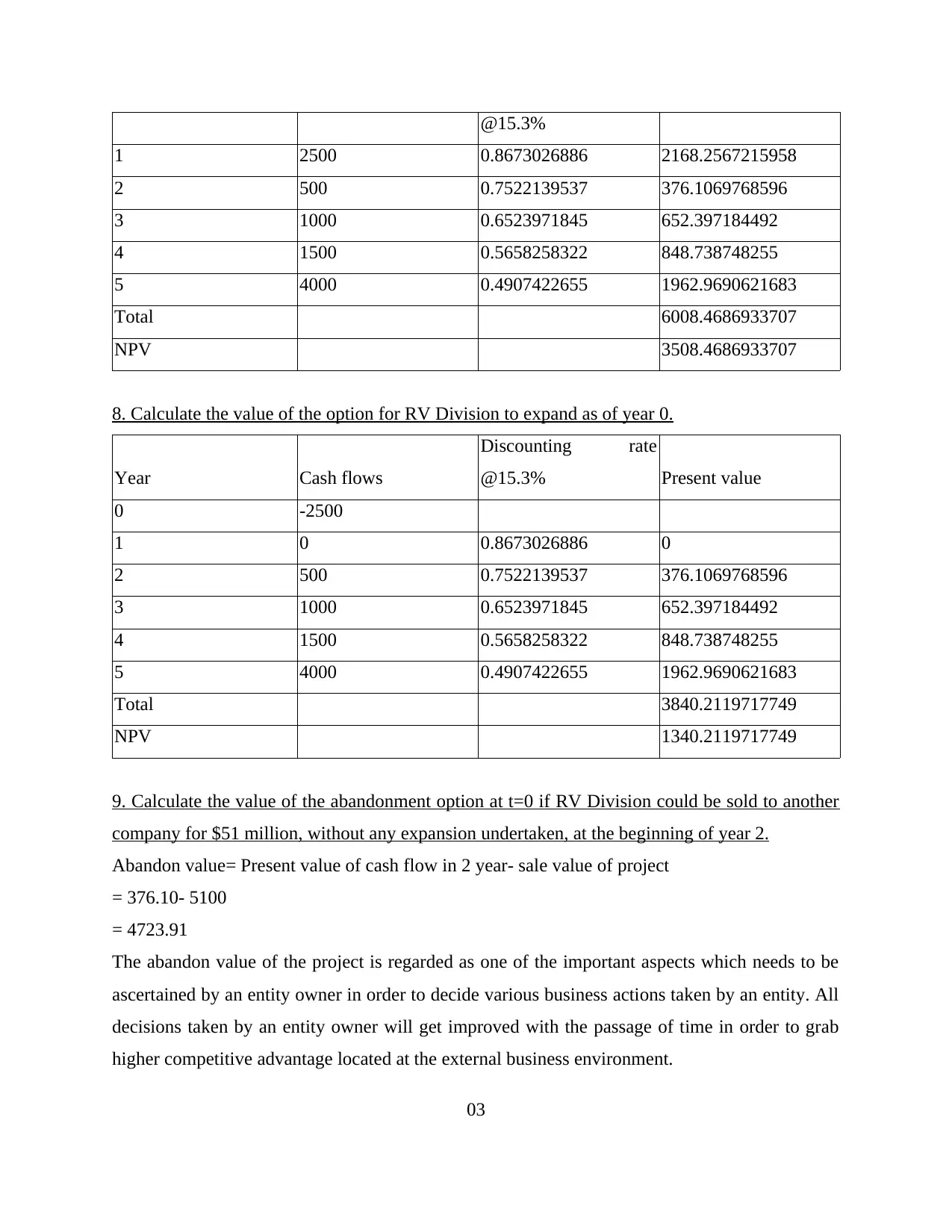
@15.3%
1 2500 0.8673026886 2168.2567215958
2 500 0.7522139537 376.1069768596
3 1000 0.6523971845 652.397184492
4 1500 0.5658258322 848.738748255
5 4000 0.4907422655 1962.9690621683
Total 6008.4686933707
NPV 3508.4686933707
8. Calculate the value of the option for RV Division to expand as of year 0.
Year Cash flows
Discounting rate
@15.3% Present value
0 -2500
1 0 0.8673026886 0
2 500 0.7522139537 376.1069768596
3 1000 0.6523971845 652.397184492
4 1500 0.5658258322 848.738748255
5 4000 0.4907422655 1962.9690621683
Total 3840.2119717749
NPV 1340.2119717749
9. Calculate the value of the abandonment option at t=0 if RV Division could be sold to another
company for $51 million, without any expansion undertaken, at the beginning of year 2.
Abandon value= Present value of cash flow in 2 year- sale value of project
= 376.10- 5100
= 4723.91
The abandon value of the project is regarded as one of the important aspects which needs to be
ascertained by an entity owner in order to decide various business actions taken by an entity. All
decisions taken by an entity owner will get improved with the passage of time in order to grab
higher competitive advantage located at the external business environment.
03
1 2500 0.8673026886 2168.2567215958
2 500 0.7522139537 376.1069768596
3 1000 0.6523971845 652.397184492
4 1500 0.5658258322 848.738748255
5 4000 0.4907422655 1962.9690621683
Total 6008.4686933707
NPV 3508.4686933707
8. Calculate the value of the option for RV Division to expand as of year 0.
Year Cash flows
Discounting rate
@15.3% Present value
0 -2500
1 0 0.8673026886 0
2 500 0.7522139537 376.1069768596
3 1000 0.6523971845 652.397184492
4 1500 0.5658258322 848.738748255
5 4000 0.4907422655 1962.9690621683
Total 3840.2119717749
NPV 1340.2119717749
9. Calculate the value of the abandonment option at t=0 if RV Division could be sold to another
company for $51 million, without any expansion undertaken, at the beginning of year 2.
Abandon value= Present value of cash flow in 2 year- sale value of project
= 376.10- 5100
= 4723.91
The abandon value of the project is regarded as one of the important aspects which needs to be
ascertained by an entity owner in order to decide various business actions taken by an entity. All
decisions taken by an entity owner will get improved with the passage of time in order to grab
higher competitive advantage located at the external business environment.
03
Paraphrase This Document
Need a fresh take? Get an instant paraphrase of this document with our AI Paraphraser
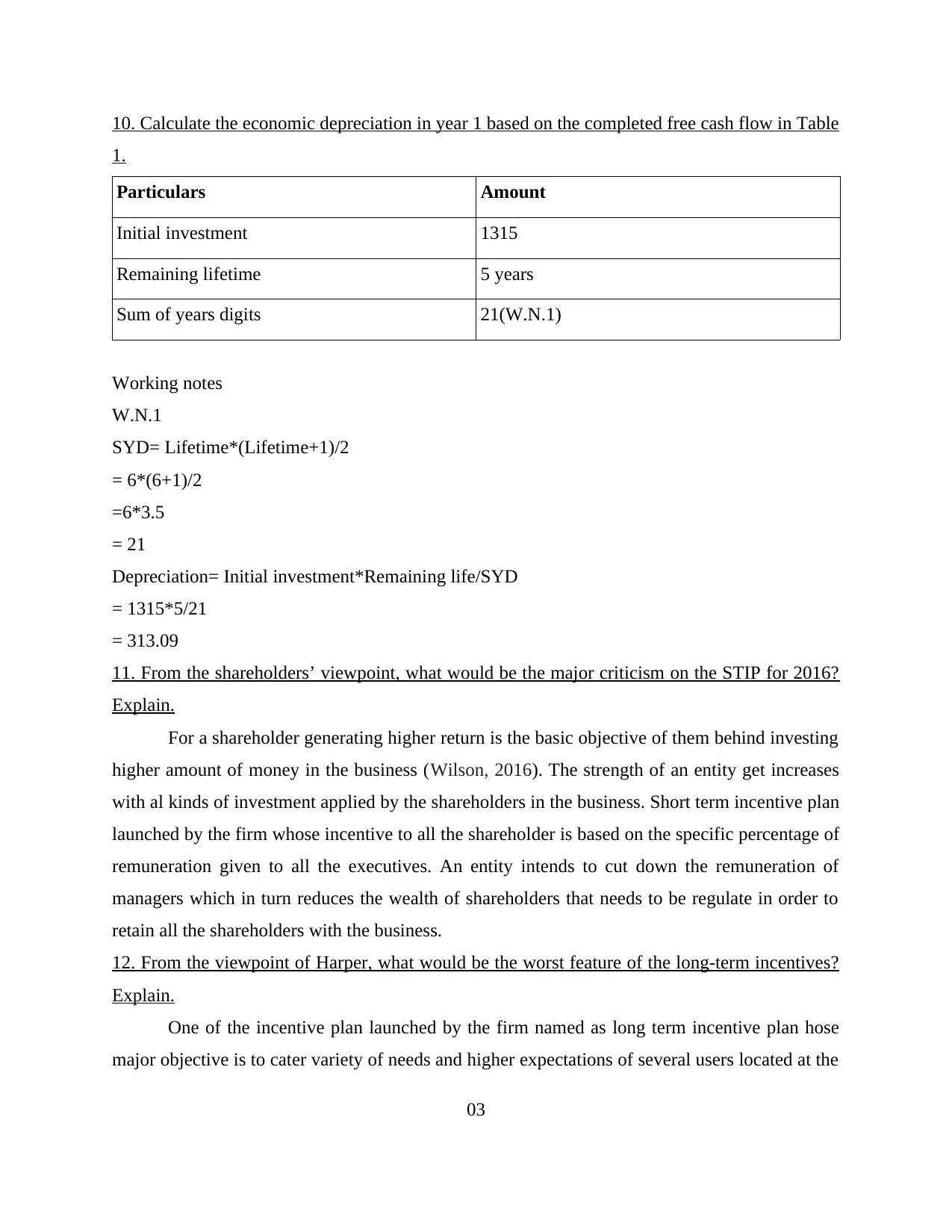
10. Calculate the economic depreciation in year 1 based on the completed free cash flow in Table
1.
Particulars Amount
Initial investment 1315
Remaining lifetime 5 years
Sum of years digits 21(W.N.1)
Working notes
W.N.1
SYD= Lifetime*(Lifetime+1)/2
= 6*(6+1)/2
=6*3.5
= 21
Depreciation= Initial investment*Remaining life/SYD
= 1315*5/21
= 313.09
11. From the shareholders’ viewpoint, what would be the major criticism on the STIP for 2016?
Explain.
For a shareholder generating higher return is the basic objective of them behind investing
higher amount of money in the business (Wilson, 2016). The strength of an entity get increases
with al kinds of investment applied by the shareholders in the business. Short term incentive plan
launched by the firm whose incentive to all the shareholder is based on the specific percentage of
remuneration given to all the executives. An entity intends to cut down the remuneration of
managers which in turn reduces the wealth of shareholders that needs to be regulate in order to
retain all the shareholders with the business.
12. From the viewpoint of Harper, what would be the worst feature of the long-term incentives?
Explain.
One of the incentive plan launched by the firm named as long term incentive plan hose
major objective is to cater variety of needs and higher expectations of several users located at the
03
1.
Particulars Amount
Initial investment 1315
Remaining lifetime 5 years
Sum of years digits 21(W.N.1)
Working notes
W.N.1
SYD= Lifetime*(Lifetime+1)/2
= 6*(6+1)/2
=6*3.5
= 21
Depreciation= Initial investment*Remaining life/SYD
= 1315*5/21
= 313.09
11. From the shareholders’ viewpoint, what would be the major criticism on the STIP for 2016?
Explain.
For a shareholder generating higher return is the basic objective of them behind investing
higher amount of money in the business (Wilson, 2016). The strength of an entity get increases
with al kinds of investment applied by the shareholders in the business. Short term incentive plan
launched by the firm whose incentive to all the shareholder is based on the specific percentage of
remuneration given to all the executives. An entity intends to cut down the remuneration of
managers which in turn reduces the wealth of shareholders that needs to be regulate in order to
retain all the shareholders with the business.
12. From the viewpoint of Harper, what would be the worst feature of the long-term incentives?
Explain.
One of the incentive plan launched by the firm named as long term incentive plan hose
major objective is to cater variety of needs and higher expectations of several users located at the
03
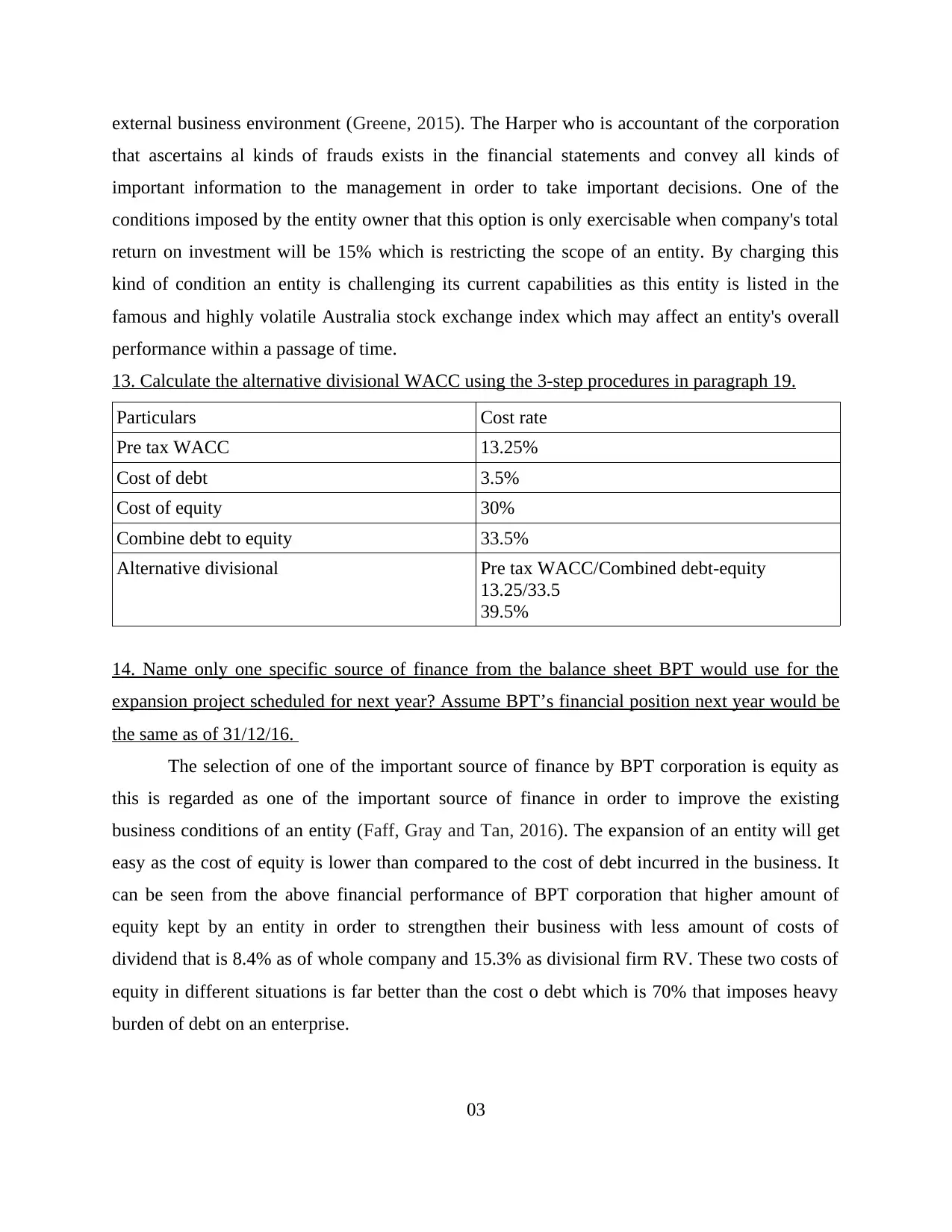
external business environment (Greene, 2015). The Harper who is accountant of the corporation
that ascertains al kinds of frauds exists in the financial statements and convey all kinds of
important information to the management in order to take important decisions. One of the
conditions imposed by the entity owner that this option is only exercisable when company's total
return on investment will be 15% which is restricting the scope of an entity. By charging this
kind of condition an entity is challenging its current capabilities as this entity is listed in the
famous and highly volatile Australia stock exchange index which may affect an entity's overall
performance within a passage of time.
13. Calculate the alternative divisional WACC using the 3-step procedures in paragraph 19.
Particulars Cost rate
Pre tax WACC 13.25%
Cost of debt 3.5%
Cost of equity 30%
Combine debt to equity 33.5%
Alternative divisional Pre tax WACC/Combined debt-equity
13.25/33.5
39.5%
14. Name only one specific source of finance from the balance sheet BPT would use for the
expansion project scheduled for next year? Assume BPT’s financial position next year would be
the same as of 31/12/16.
The selection of one of the important source of finance by BPT corporation is equity as
this is regarded as one of the important source of finance in order to improve the existing
business conditions of an entity (Faff, Gray and Tan, 2016). The expansion of an entity will get
easy as the cost of equity is lower than compared to the cost of debt incurred in the business. It
can be seen from the above financial performance of BPT corporation that higher amount of
equity kept by an entity in order to strengthen their business with less amount of costs of
dividend that is 8.4% as of whole company and 15.3% as divisional firm RV. These two costs of
equity in different situations is far better than the cost o debt which is 70% that imposes heavy
burden of debt on an enterprise.
03
that ascertains al kinds of frauds exists in the financial statements and convey all kinds of
important information to the management in order to take important decisions. One of the
conditions imposed by the entity owner that this option is only exercisable when company's total
return on investment will be 15% which is restricting the scope of an entity. By charging this
kind of condition an entity is challenging its current capabilities as this entity is listed in the
famous and highly volatile Australia stock exchange index which may affect an entity's overall
performance within a passage of time.
13. Calculate the alternative divisional WACC using the 3-step procedures in paragraph 19.
Particulars Cost rate
Pre tax WACC 13.25%
Cost of debt 3.5%
Cost of equity 30%
Combine debt to equity 33.5%
Alternative divisional Pre tax WACC/Combined debt-equity
13.25/33.5
39.5%
14. Name only one specific source of finance from the balance sheet BPT would use for the
expansion project scheduled for next year? Assume BPT’s financial position next year would be
the same as of 31/12/16.
The selection of one of the important source of finance by BPT corporation is equity as
this is regarded as one of the important source of finance in order to improve the existing
business conditions of an entity (Faff, Gray and Tan, 2016). The expansion of an entity will get
easy as the cost of equity is lower than compared to the cost of debt incurred in the business. It
can be seen from the above financial performance of BPT corporation that higher amount of
equity kept by an entity in order to strengthen their business with less amount of costs of
dividend that is 8.4% as of whole company and 15.3% as divisional firm RV. These two costs of
equity in different situations is far better than the cost o debt which is 70% that imposes heavy
burden of debt on an enterprise.
03
⊘ This is a preview!⊘
Do you want full access?
Subscribe today to unlock all pages.

Trusted by 1+ million students worldwide
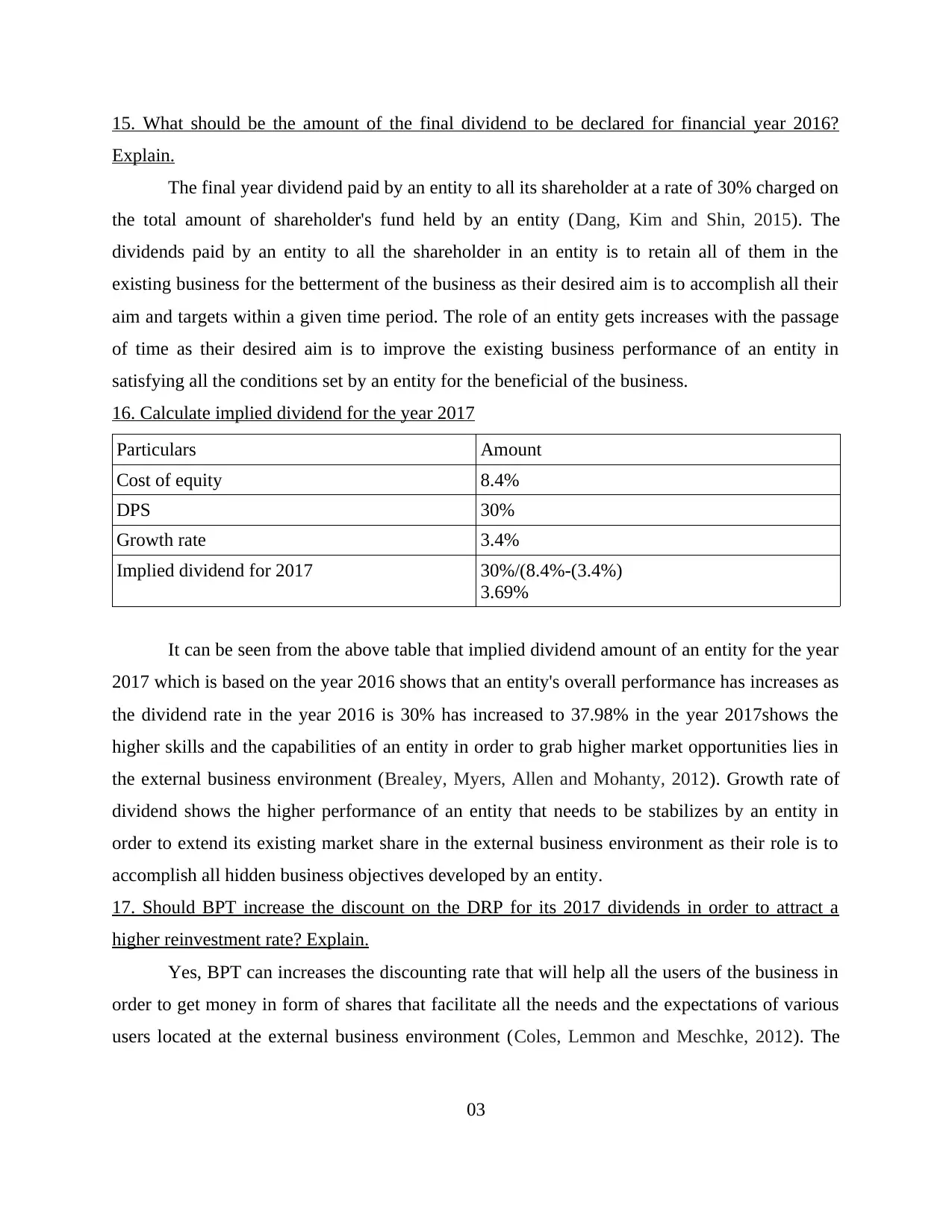
15. What should be the amount of the final dividend to be declared for financial year 2016?
Explain.
The final year dividend paid by an entity to all its shareholder at a rate of 30% charged on
the total amount of shareholder's fund held by an entity (Dang, Kim and Shin, 2015). The
dividends paid by an entity to all the shareholder in an entity is to retain all of them in the
existing business for the betterment of the business as their desired aim is to accomplish all their
aim and targets within a given time period. The role of an entity gets increases with the passage
of time as their desired aim is to improve the existing business performance of an entity in
satisfying all the conditions set by an entity for the beneficial of the business.
16. Calculate implied dividend for the year 2017
Particulars Amount
Cost of equity 8.4%
DPS 30%
Growth rate 3.4%
Implied dividend for 2017 30%/(8.4%-(3.4%)
3.69%
It can be seen from the above table that implied dividend amount of an entity for the year
2017 which is based on the year 2016 shows that an entity's overall performance has increases as
the dividend rate in the year 2016 is 30% has increased to 37.98% in the year 2017shows the
higher skills and the capabilities of an entity in order to grab higher market opportunities lies in
the external business environment (Brealey, Myers, Allen and Mohanty, 2012). Growth rate of
dividend shows the higher performance of an entity that needs to be stabilizes by an entity in
order to extend its existing market share in the external business environment as their role is to
accomplish all hidden business objectives developed by an entity.
17. Should BPT increase the discount on the DRP for its 2017 dividends in order to attract a
higher reinvestment rate? Explain.
Yes, BPT can increases the discounting rate that will help all the users of the business in
order to get money in form of shares that facilitate all the needs and the expectations of various
users located at the external business environment (Coles, Lemmon and Meschke, 2012). The
03
Explain.
The final year dividend paid by an entity to all its shareholder at a rate of 30% charged on
the total amount of shareholder's fund held by an entity (Dang, Kim and Shin, 2015). The
dividends paid by an entity to all the shareholder in an entity is to retain all of them in the
existing business for the betterment of the business as their desired aim is to accomplish all their
aim and targets within a given time period. The role of an entity gets increases with the passage
of time as their desired aim is to improve the existing business performance of an entity in
satisfying all the conditions set by an entity for the beneficial of the business.
16. Calculate implied dividend for the year 2017
Particulars Amount
Cost of equity 8.4%
DPS 30%
Growth rate 3.4%
Implied dividend for 2017 30%/(8.4%-(3.4%)
3.69%
It can be seen from the above table that implied dividend amount of an entity for the year
2017 which is based on the year 2016 shows that an entity's overall performance has increases as
the dividend rate in the year 2016 is 30% has increased to 37.98% in the year 2017shows the
higher skills and the capabilities of an entity in order to grab higher market opportunities lies in
the external business environment (Brealey, Myers, Allen and Mohanty, 2012). Growth rate of
dividend shows the higher performance of an entity that needs to be stabilizes by an entity in
order to extend its existing market share in the external business environment as their role is to
accomplish all hidden business objectives developed by an entity.
17. Should BPT increase the discount on the DRP for its 2017 dividends in order to attract a
higher reinvestment rate? Explain.
Yes, BPT can increases the discounting rate that will help all the users of the business in
order to get money in form of shares that facilitate all the needs and the expectations of various
users located at the external business environment (Coles, Lemmon and Meschke, 2012). The
03
Paraphrase This Document
Need a fresh take? Get an instant paraphrase of this document with our AI Paraphraser
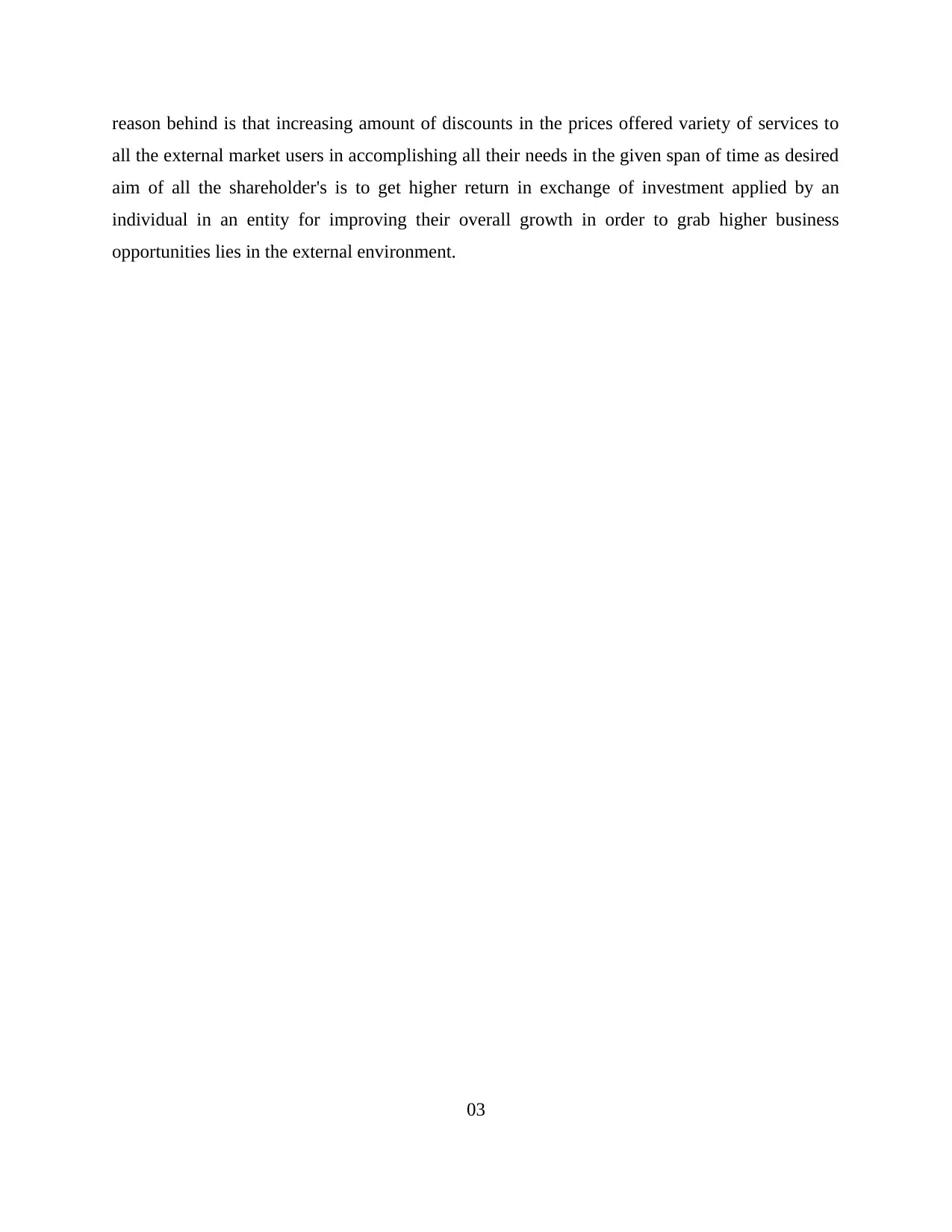
reason behind is that increasing amount of discounts in the prices offered variety of services to
all the external market users in accomplishing all their needs in the given span of time as desired
aim of all the shareholder's is to get higher return in exchange of investment applied by an
individual in an entity for improving their overall growth in order to grab higher business
opportunities lies in the external environment.
03
all the external market users in accomplishing all their needs in the given span of time as desired
aim of all the shareholder's is to get higher return in exchange of investment applied by an
individual in an entity for improving their overall growth in order to grab higher business
opportunities lies in the external environment.
03
1 out of 11
Related Documents
Your All-in-One AI-Powered Toolkit for Academic Success.
+13062052269
info@desklib.com
Available 24*7 on WhatsApp / Email
![[object Object]](/_next/static/media/star-bottom.7253800d.svg)
Unlock your academic potential
Copyright © 2020–2025 A2Z Services. All Rights Reserved. Developed and managed by ZUCOL.




